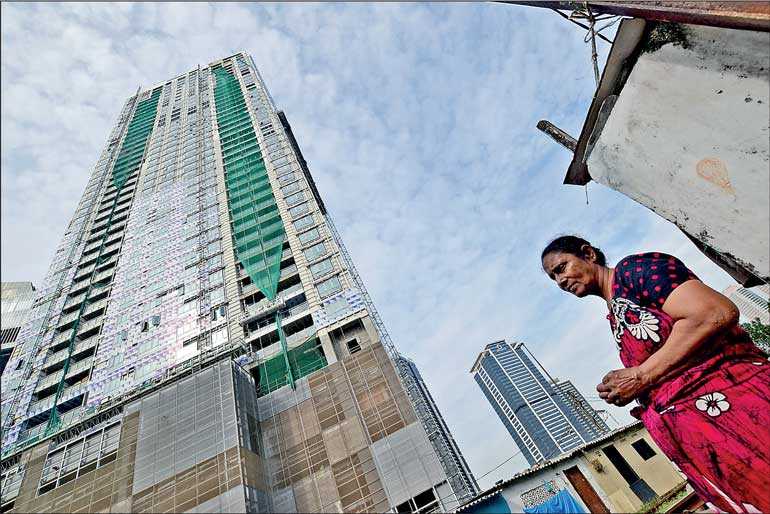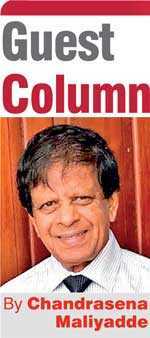Monday Dec 22, 2025
Monday Dec 22, 2025
Wednesday, 12 May 2021 00:00 - - {{hitsCtrl.values.hits}}

Can the poor afford to save? There are poor debtors and rich savers in society. A high-interest rate would offer a higher income to rich savers and high prices to poor savers, widening the already existing income inequality, which is another achievement of the liberal economy – Pic by Shehan Gunasekara
 I read with a lot of interest the article on ‘Low-interest rate policy punishes savers’ by our good friend Prof. Sirimevan Colombage. He has shown a great deal of mercy towards the poor and ageing community.
I read with a lot of interest the article on ‘Low-interest rate policy punishes savers’ by our good friend Prof. Sirimevan Colombage. He has shown a great deal of mercy towards the poor and ageing community.
I wonder whether ageing has disturbed his brilliant thought pattern. He talks more of spiritual aspects of life (mercy and thriftiness) rather than the discipline of materialistic economics (greed and investment) that he mastered throughout his career as a central banker, an academic and a researcher.
Being a strong advocate of neo liberalistic economics, it is surprising that he laments the fallouts (aged and poor) rather than boasting of the declared gains (growth and poverty reduction) of trade liberalisation.
He states: “With the continuous rise in the cost of living, the people in low-income categories who depend heavily on interest income for their living, particularly in their old age, are the most severely affected by the fall in interest rates.”
In 1978, the newly-elected JRJ Government announced four main programs: Trade Liberalisation, Establishment of Export Processing Zones, Mahaweli Development and Integrated Rural Development Program (IRDP). The first three programs were aimed at pushing the overall growth of the economy. The motto behind IRDP was to cater to those who would fail to be benefitted (fallouts) by the other three programs.
According to Colombage himself, the “poverty ratio is likely to have reached nearly 50% of the population by now” after adhering to trade liberalisation for over 40 years. To this layman, Colombage’s logic is ‘continue with trade liberalisation, produce more poor and increase the interest rate to help the poor’.
Disadvantages of liberalisation
The economic system that prevailed before the introduction of a liberal economy, whatever you named it, was inclusive and catered to all segments of the population. The family was a single integrated unit. But liberalisation disintegrated the family and divided as women, youths and children. Widening income inequality created poverty. The widening gap created regional and rural/urban imbalance.
New institutions or new ministries were created to take care of the fallouts of the liberal economy. Youth Affairs, Women’s Affairs, Children’s Affairs, Poverty Alleviation, Rural Development, Urban Development, and Regional Development are some subjects introduced by the liberal economy. Each subject had more than one institution or a ministry. Each minister responsible for each new subject introduced a new fund and a new lottery.
Prior to the introduction of the liberal economy, there was only one main lottery in the country, i.e. the National Lottery. The liberal economy introduced many more lotteries depending on the number and the fancy of ministers. Lotteries were proliferated to cater to each fallout of the liberal economy.
Today, we have ended up with two main lotteries, National Lottery and Development Lottery (incidentally, I am responsible for promoting the latter). Both have introduced a ticket for each day along with a daily draw. Instead of one single draw per week, there are 14 lottery draws per week conducted by the two lotteries. They announce producing a millionaire or a billionaire daily. They end up producing a millionaire once in a blue moon and many millions of poor daily. Will these fallouts of the liberal economy be included in the category which deserves the higher interest rates that liberal economic advocates promote?
According to Prof. Colombage, the “share of population above 64 years doubled from 5% to more than 10% during this period” and “since the mid-1970s the share of the younger cohorts of the population has continued to fall”.
Trade liberalisation
Trade liberalisation too was introduced in mid-1970s. The falling of younger cohorts and trade liberalisation is not merely coincidental; it is consequential. Unfortunately, he has forgotten or purposely making us forget that the most causes for ageing lie in the liberal economic policy adoption.
Before liberalisation, the rural community was more content and productive. They had bountiful agriculture-based and agriculture-related opportunities within the village to earn an extra rupee. Transport and communication systems were not developed (or is it modernised) as they are today and discouraged the mobility of rural people.
Handloom industry, cottage industry, handicrafts, smithies, repair and maintenance and a host of other activities kept them occupied and retained them in the village. Overnight liberalisation in 1978 wiped out all such complementary and supplementary opportunities available for the rural community.
Imported cosmetics and jumping fish were available for girls and imported cigarettes and liquor was available for boys. Imported apples and grapes were available for both. And without their knowledge but, with the knowledge of rulers, the rural economy and opportunities in the rural sector gradually got eroded.
The Government dangled the carrot of the Accelerated Mahaweli program and the Katunayake Export Processing Zone. Girls shifted from handloom to the power loom; boys shifted from traditional agriculture to modernised agriculture.
Marriage was declined, discouraged, delayed and deprived. Some have passed their best fertile age; some have limited their fertility; some cannot afford to bear children; some are under-nutrient and mal-nutrient and cannot rare, breed and feed babies; some have refused births as the imported cosmetics failed to hide the protruding belly.
Boys who went to Mahaweli in search of modern commercialised agriculture have been losing their life to elephants, mosquitoes, illicit liquor, drugs and chemicals. Some ended up sick, disabled, inactive and bedridden.
The liberal economy instead of modernising, commercialising and making it more economical, pushed down agriculture from 50% to 7% of GDP and pushed out the people from the village to the town. Liberal economic concept careers would try to teach me a bit of the theory that the declining share of agriculture in GDP is a sign of development. Neglecting agriculture is totally another story. The liberal economy has taken the prime life of youths leaving the old like Colombage and me behind.
The liberal economy
The liberal economy and its showpieces attracted girls; they moved out to urban areas in search of employment. They were deprived of shelter, sanitation, serenity, confidence, security and care. They are basics for a girl to settle down for marriage and bear children. Their meagre wage, unsettled mind and lust for love attracted them to urban boys. Some lost their love; some lost jobs; some lost shelter; some lost virginity; some lost life. The remaining lot either went back home or ended up as prostitutes to supplement their meagre wage.
The liberal economy paved the way for professionals to supplement their salary through private practice. Doctors who work in public hospitals work hard to prevent the life of mothers and babies, to reduce the infant mortality rate. They work hard to eliminate the conception in private hospitals. Some health centres promote births during day time and abort births after dusk. Eliminating a birth has become more lucrative than saving a birth. The liberal economy offered two options; save a life and save money; eliminate life and make money. Liberal economists are economic doctors but not medical doctors.
Colombage attributes the low fertility rate and increasing life expectancy to the country’s improved medical facilities for Sri Lanka to be a fast population-ageing country. While agreeing with him, we should not forget that there are other reasons forgotten by liberal economy advocates.
Money, fame, showpieces are all in curative medicine. The liberal economy placed emphasis and invested heavily in curative medicine at the expense of the primary healthcare facilities. This has increased deaths and disability among youths caused by non-communicable diseases, viral infection, polluted air and water.
After the introduction of the liberal economy, a nationwide birth control program was launched by the Government. So-called lucrative job opportunities attracted healthy rural women to urban areas and the Middle East, delaying, depriving or breaking marriages. Medical centres were turned into spas, massage parlours and abortion centres. Drugs, liquor and weapons were freely available and youths were attracted to them.
Being one of the few countries which is unable to produce even a toy car, Sri Lanka has become a showcase of all types of vehicles of the latest, fastest, most expensive and luxury models thanks to liberal trade. The liberal economy inherited us a well-paved road network to drive our luxury sedans to death and disability. Who are the victims? Mothers, children and youth, leaving the ageing behind to depend on the interest earned on their imaginary savings.
Can the poor afford to save?
Colombage laments that the low-interest rate has punished poor savers by offering low yields for their lifetime savings. Who are these poor savers? Can the poor afford to save? There are poor debtors and rich savers in society. A high-interest rate would offer a higher income to rich savers and high prices to poor savers, widening the already existing income inequality, which is another achievement of the liberal economy.
Liberal trade and liberal economy advocates expected or misbelieved that it would bring investment, revenue from tourism and exports and accelerate growth and generate more employment opportunities. But it has endowed us an import-dependent lagging economy with an army of dependents. It is not the fallout but it is the total result. They now shedding tears on the plight of savers to cover their failure.
Low-interest rate stimulates investment. High-interest rate stimulates savings. So says the theory. Are neo liberal economists yearning for a savings-dependent society of poor and aged as the investment-driven economy they dreamed for 40 years has never dawned?
I would like to conclude with a quote from Kartik Athreya, Executive Vice President and Director of Research at the Federal Reserve Bank of Richmond in his article ‘Do Low-Interest Rates Punish Savers’ in Econ Focus, third quarter 2017: “Had the Fed’s policy rates instead been higher, the evidence suggests that economic outcomes would have been considerably worse. From this perspective, higher rates would likely have been detrimental to savers and virtually all households. Moreover, savers are not just savers — they are also participants in the overall economy. Many are workers: As noted, if rates had instead been higher in recent years, employment outcomes would surely have been worse, and job loss is typically a more traumatic financial event than the losses one faces when asset returns experience a cyclical decline. Savers are also consumers, and lower Fed policy rates generally mean lower loan rates for goods like homes and automobiles, as well as lower interest payments on variable rate loans. Finally, many savers also hold assets whose values tend to rise in low-interest-rate environments. Low rates tend to boost housing prices, for example, and the housing comprises a large majority — nearly two-thirds — of assets for households in the middle of the wealth distribution. This is especially true of older households preparing for retirement; roughly 80% of households aged 65 and older own their homes, compared to roughly 64% for the nation as a whole, according to the Census Bureau.”
(The writer has served as a Secretary to three Ministries before his retirement. He is currently a Vice President of Sri Lanka Economic Association. He can be reached via [email protected])